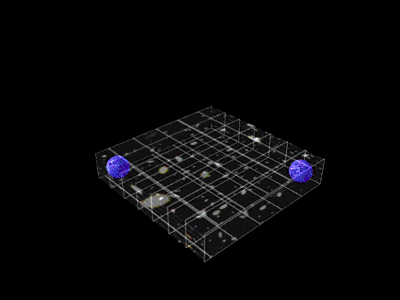Can we prove realms exist beyond our plane ... or ‘brane’?

An animated image shows a collision between two subatomic particles embedded in our 3-D universe (or "brane"). The collision produces other particles, including a graviton that escapes from our brane into the extradimensional "bulk" that lies beyond.
SEATTLE - The cosmos would make perfect sense … if it turns out we're living in a 10- or 11-dimensional realm where gravity is bubbling off a different plane entirely. At least that's what's emerging as the hottest concept on the frontier of physics.
Though these sound like virtually unverifiable claims, physicists are trying to come up with ways to gather evidence to back up or disprove the extradimensional theories currently in vogue. But it’ll take several years to get that evidence, if it can be gotten at all.
The claim that the cosmos has more than the four dimensions we can perceive — that is, three spatial dimensions plus time — is exotic enough. But the quest to prove that claim brings in a virtual menagerie of mysteries: mini-black holes and dark matter, gravitational waves and cosmic inflation, super-high-energy particle collisions and ultra-powerful gamma-ray bursts.
Even the physicists behind today's most-talked-about extradimensional theory, Harvard University's Lisa Randall and Johns Hopkins University's Raman Sundrum, aren't yet exactly sure whether the approaches will pay off.
"Nothing comes with a money-back guarantee," Sundrum told MSNBC.com.
So why bother? Physicists aren't just spinning out these tales of 11 dimensions for the amusement of science-fiction writers. Rather, unseen dimensions seem to offer the best hope for solving the kinds of problems that have frustrated theorists since Albert Einstein's day.
The incredible lightness of gravity For decades, physicists have puzzled over the weakness of gravity in comparison with the other fundamental forces of nature.
"A tiny magnet can lift a paper clip, even though all the mass of the earth is pulling it in the opposite direction," Randall noted in her book on the search for extra dimensions, titled "Warped Passages."
Einstein tried to come up with an overarching theory that could apply equally well to gravity and the other forces, but just couldn't do it. In fact, the theories that govern gravity and quantum mechanics are totally separate, and totally incompatible in the four-dimensional world we know.
Over the past couple of decades, Einstein's successors have focused their quest for a "theory of everything" on string theory — the idea that the fundamental constituents of matter are tiny stringlike objects vibrating at different frequencies. String theorists could come up with equations to cover gravity as well as quantum effects, as long as they were given 10 or 11 dimensions to work with.
Straining to explain branes The theories work even better if you can think of our four-dimensional space-time continuum as a type of membrane, or "brane," embedded in a "bulk" that takes in even more dimensions. Randall and Sundrum found that gravity's comparative weakness was perfectly understandable if particles called gravitons could leak off a brane into a five-dimensional bulk. In fact, they said, it could well be that gravitons are leaking across the bulk into our own brane (the "Weakbrane") from an extradimensional brane nearby (the "Gravitybrane").
Admittedly, this sounds like a made-up world straight from "Alice in Wonderland" — and indeed, Alice has been invoked more than once by theorists themselves. The only thing that could save extradimensional physics from the fiction shelf is the prospect of finding real-world evidence to support the braneworld concept.
Although there are no guarantees, Randall and Sundrum are holding out hope that ambitious experiments will soon produce precisely that kind of evidence. "Within the next five years, we might actually encounter these extra dimensions," Randall said during a talk last week in Seattle.
Smashing particles The problem with detecting the fifth dimension (or the sixth, seventh, and so on) is that our bodies are built to measure only the three old-fashioned spatial dimensions, plus time as a fourth dimension.
Scientists have been hoping that at least one of the extra dimensions might be rolled up in such a way that its influence could be seen by measuring gravity's pull on a scale of, say, a millimeter or less. So far, no anomalies have been officially reported, although there have been occasional blips that are likely due to tiny experimental errors rather than the fifth dimension.
A more promising avenue should start to open up next year, when a 5.3-mile-wide (8.6-kilometer-wide) underground particle accelerator comes online at Europe's CERN laboratory, on the French-Swiss border. The accelerator, dubbed the Large Hadron Collider , just might be able to smash protons together with enough energy to spawn subatomic particles that have momentum in the extra dimensions.
This momentum, Randall said, would be seen as extra mass. So if the LHC produces classes of new particles that carry the same charges as normal particles but appear to be heavier by certain amounts, that could be a tip-off to the fifth dimension. If the theory is correct, such anomalies should be detected "probably within a few years of runs at CERN," Randall said.
Detecting gravitational waves Randall said another avenue could have to do with gravity waves — a phenomenon that is predicted by Einstein's general relativity theory but has not yet been detected. Components of the $365 million Laser Interferometer Gravitational-Wave Observatory, or LIGO, are just getting up to speed in Louisiana and Washington state.

Physicists Lisa Randall and Raman Sundrum have developed a five-dimensional model to explain why gravity is so much weaker than the other fundamental forces.
Physicists have said there's a chance that LIGO may achieve the first-ever detection of gravity waves, and almost 200,000 users have signed up to help to process LIGO data through the Einstein @ Home distributed-computing project. But Randall told MSNBC.com that not even LIGO would be able to pick up the data she's looking for.
Randall and Sundrum speculate that the space we inhabit and see all around us may have made a transition from a more overtly extradimensional state early on — perhaps as part of the process of cosmic inflation.
"The extradimensional picture may actually contain an inflation mechanism which, under favorable circumstances, would produce observable gravitational waves, the details of which may give away some features of their extradimensional origin," Sundrum explained.
Although LIGO wouldn't be sensitive enough to pick up on that extradimensional fingerprint, Randall said a future U.S.-European space probe known as the Laser Interferometer Space Antenna, or LISA, just might have a chance.
Sundrum, however, said the theoretical linkage between extra dimensions and cosmic inflation "has not yet hit that robust note on which you could base strong conclusions." Moreover, it's not clear exactly when LISA might be launched. The current best guess is sometime before the year 2014.
Catching gamma-ray bursts Just in the past couple of weeks, two other physicists have suggested a different avenue for testing the Randall-Sundrum theory. This would involve using a NASA probe called the Gamma-Ray Large Area Space Telescope, or GLAST, which is due for launch next year.
In their paper, published online May 24 in the journal Physical Review D, Rutgers University's Charles Keeton and Duke University's Arlie Petters focus on a particular type of miniature black hole that appears to be predicted as an outgrowth of the extradimensional warping effect.
"This is something with the mass of an asteroid, but it's microscopic in size," Petters told MSNBC.com.
If the mini-black holes exist, Keeton and Petters say GLAST should register a characteristic light-bending effect as it observes bursts of gamma rays from distant sources. Such an experiment could prove that brane theory comes closer to the truth than Einstein's relativity theory — and could also lend weight to the idea that the mini-black holes account for at least some of our universe's mysterious dark matter.
"If braneworld black holes form even 1 percent of the dark matter in our part of the galaxy — a cautious assumption — there should be several thousand braneworld black holes in our solar system," Petters said.
Randall and Sundrum told MSNBC.com that they were initially skeptical about the ideas proposed by Keeton and Petters, but they are still reviewing the details. For now, Sundrum said he was willing to give the researchers the benefit of the doubt: "You give them more rope, because if they're right, then it's off-the-scale fantastic."
The important thing is that physicists are actually coming up with ideas to test hypotheses that seemed untestable not so long ago, Keeton told MSNBC.com.
"We're proposing a new test of the braneworld model, but it's certainly not the only possibility," he said. "This fits into the broader picture of the community trying to test this."
If the mini-black holes exist, Keeton and Petters say GLAST should register a characteristic light-bending effect as it observes bursts of gamma rays from distant sources. Such an experiment could prove that brane theory comes closer to the truth than Einstein's relativity theory — and could also lend weight to the idea that the mini-black holes account for at least some of our universe's mysterious dark matter.
"If braneworld black holes form even 1 percent of the dark matter in our part of the galaxy — a cautious assumption — there should be several thousand braneworld black holes in our solar system," Petters said.
Randall and Sundrum told MSNBC.com that they were initially skeptical about the ideas proposed by Keeton and Petters, but they are still reviewing the details. For now, Sundrum said he was willing to give the researchers the benefit of the doubt: "You give them more rope, because if they're right, then it's off-the-scale fantastic."
The important thing is that physicists are actually coming up with ideas to test hypotheses that seemed untestable not so long ago, Keeton told MSNBC.com.
"We're proposing a new test of the braneworld model, but it's certainly not the only possibility," he said. "This fits into the broader picture of the community trying to test this."

No comments:
Post a Comment